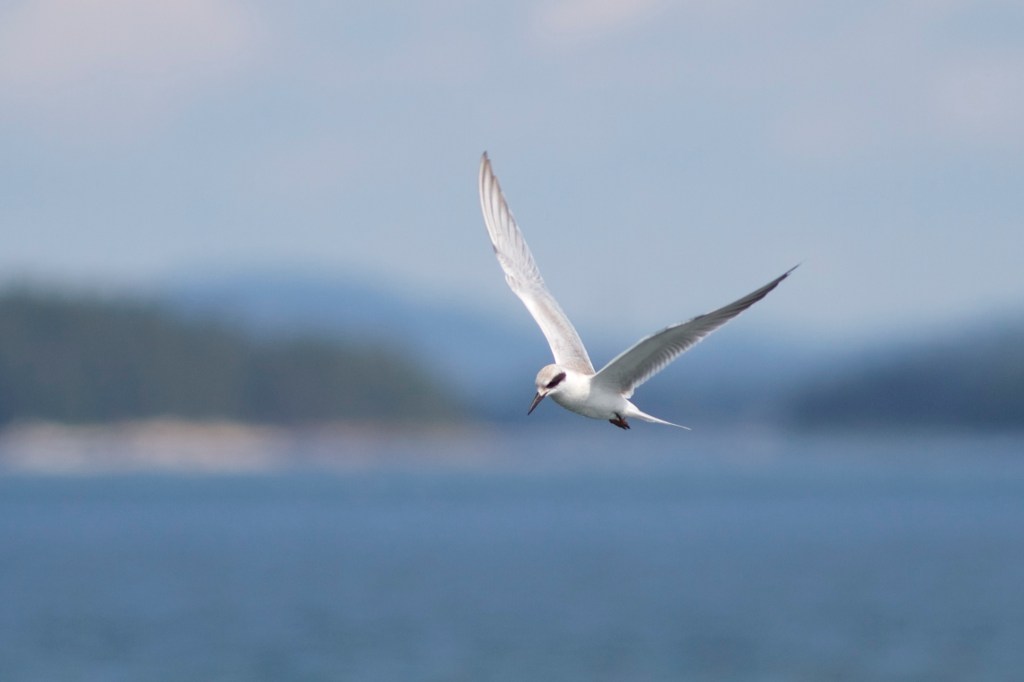
Although we are only a few days into the astrological fall (for the Northern Hemisphere), the fall migration and movement of animals has been going on for weeks, if not months. Throughout September, Maine Audubon hosts a number of trips and outings, and one thing that really stuck out this year during those outings was how frequently we saw species from all over the country. Fall migration tends to be generalized as “species moving south for the winter” but I wanted to highlight a few animals we saw over the last few weeks, to shed some light on just where the various wildlife we see in Maine is coming from.
On Sept. 14, we ran our annual pelagic trip out of Bar Harbor. This is a half-day boat trip where we charter Bar Harbor Whale Watch’s 112-foot jet-powered catamaran, the Friendship V, to take us offshore looking primarily for birds that spend most of their lives at sea, also known as pelagic species. Shearwaters and storm-petrels are our targets, but one noteworthy animal of the trips was a cetacean, a humpback whale we encountered about 30 miles off Bar Harbor.
Humpbacks have unique patterns on the undersides of their flukes (the two lobes of the tail), and thanks to a database of photographs, you can look up known individuals and see where they’ve been. This was the case with our whale, a humpback named “NewJersey” (given the ID number NA-10964) that had first been photographed in August 2017, in (approximately) New Jersey waters, very close to New York City. After that initial sighting, it was found in Cape Cod Bay in July 2020, and has since been reported five times in the Gulf of Maine, including from whale watches out of Kennebunk and Boothbay. You can go to happywhale.com to see this or other tracks.
Arguably less charismatic than a whale, an American herring gull was encountered on that same trip. OK, we saw hundreds of gulls, but one herring gull was wearing a field-readable band that was tracked back to a population from Lake Erie. One technique used to track individual birds is to put a marker on them. Gulls are large enough to be able to have bands on their legs that can be read with binoculars or from a photograph. These bands usually have a unique color, and the text is an alpha-numeric code for each individual. We also spotted, in that same group, a gull with an orange band and black lettering (“MOV”), likely a local nester. Earlier this year, a gull that was banded on Mount Desert Rock as a chick in 2024 was spotted wintering on Sanibel Island in Florida.
Another bit of excitement over the past month, seen all along the Maine coast, was an incursion of Forster’s terns. Anyone spending time along the coast in summer will probably be familiar with terns. These slender cousins of gulls are often seen diving into the water for fish, with common terns and beach-nesting least terns being the most regularly encountered. Forster’s terns nest in small numbers in the mid-Atlantic states, but more abundantly to our west, in marshes from the Dakotas to Alberta. Most years, we see small numbers in the fall, and sometimes hurricanes push them north, with low double-digit counts known to occur. This year, there are dozens up and down the coast. As of writing this, a new “high count” for the state had just been set, with 29 Forster’s terns being observed at one time at Hills Beach in Biddeford.
The last stand-out sighting I’ll mention was a northern wheatear found in Scarborough Marsh in mid-September. This funny-named bird belongs in the family muscicapidae, which are the old world flycatchers, but these (and bluethroats, found only in Alaska) are the only new world breeders. Wheatears have a circumpolar breeding distribution, mostly across flat tundra, but the entire population migrates to sub-Saharan Africa for the winter. It is the population in eastern Canada that crosses the Atlantic en route to wintering grounds, so this Scarborough bird probably ventured a bit farther south than usual before making the leap east.
The migratory period is a tough time for most animals as they move to areas where food will be available. I hope these quick stories of whales and birds using Maine habitat at various points of their life cycle help connect some dots and remind us just how connected the whole world is.
Have you got a nature or wildlife question of your own? It doesn’t have to be about birds! Email questions to [email protected] and visit maineaudubon.org to learn more about birding, native plants, and programs and events focusing on Maine wildlife and habitat. Maine Audubon Staff Naturalist Doug Hitchcox and other naturalists lead free bird walks on Thursday mornings starting at 7 am, at Maine Audubon’s Gilsland Farm Audubon Sanctuary in Falmouth.